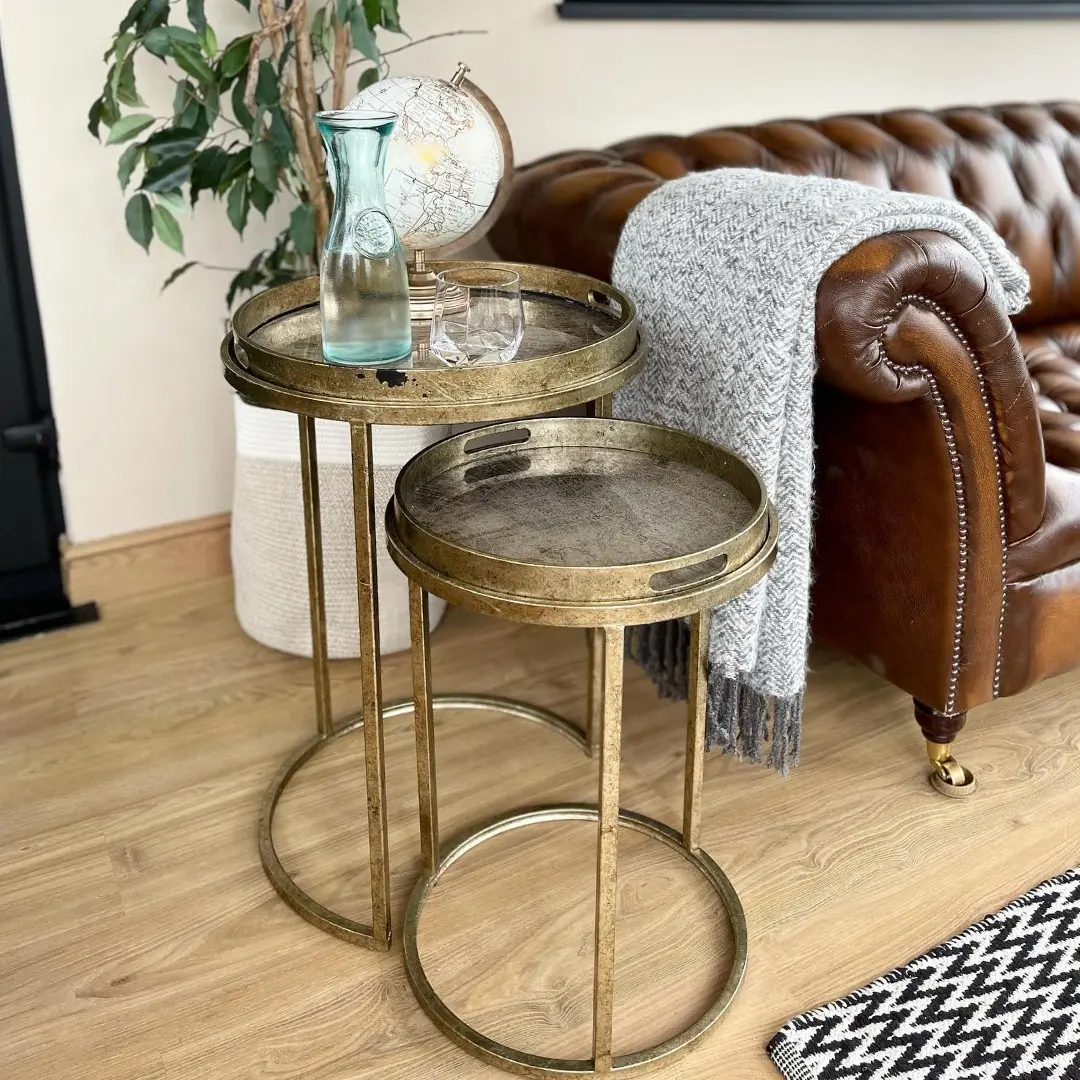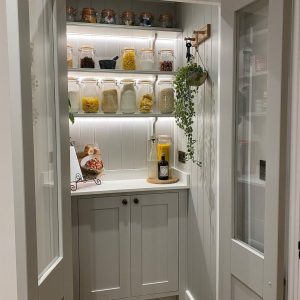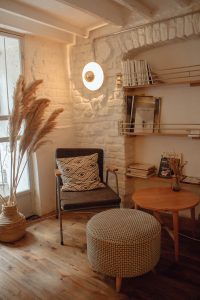Selecting the Right Small Side Table
Choosing the perfect small side table for your compact living space involves more than just picking a style you like. It requires a thoughtful consideration of size, design, and material to ensure it meets your needs and complements your decor.
Here are some suggestions to assist you in making the appropriate selection:
Size and Proportions
- Measure Your Space: Before purchasing, measure the area where you plan to place the table. Ensure there’s enough room for movement around it.
- Height Matters: The table should be at a comfortable height relative to your sofa or bed. Ideally, it should be level with the arm of the sofa or slightly lower.
- Scale: Choose a table that’s proportional to your furniture. A small, delicate table might be overshadowed by a large sofa, while a bulky table can overwhelm a petite chair.
Style and Design
- Complement Your Decor: Select a table that harmonizes with your existing decor. Whether your home is modern, traditional, or eclectic, there’s a side table that fits.
- Functionality: Consider what you’ll use the table for. If you need storage, look for tables with drawers or shelves. If it’s purely decorative, focus on the aesthetics.
- Shape: Round tables are great for softening a room full of straight lines, while square or rectangular tables can provide a sense of order and symmetry.
Material and Durability
- Wood: Offers a warm, natural look and is available in a range of finishes. Solid wood is more durable but also heavier and pricier than engineered wood.
- Metal: Provides a sleek, contemporary feel. It’s sturdy and easy to clean but can be prone to scratches.
- Glass: Creates an illusion of more space with its transparency. However, it requires regular cleaning to prevent smudges.
- Plastic or Acrylic: Ideal for modern interiors, these materials are lightweight and come in various colors. They’re also easy to move around.
Now that we know how to select the right small side table, let’s explore the various roles they can play in compact living spaces.
The Role of Small Side Tables in Compact Living
Small side tables are more than just a piece of furniture; they are a versatile and essential element in the realm of compact living. Their significance goes beyond mere aesthetics, as they serve various functional roles in tight spaces.
Definition and Purpose
A small side table is a compact, lightweight table that can easily fit into narrow spaces. Typically placed next to a sofa, bed, or chair, these tables offer a convenient surface for items like books, drinks, or a table lamp. Their primary purpose is to enhance the functionality of a living area without occupying much space.
Space-saving Solutions
In compact living environments, every square inch counts. Small side tables are ideal for such settings as they take up minimal space while providing essential surface area. They can be easily moved or tucked away when not in use, making them perfect for flexible living arrangements.
Versatility
The true beauty of small side tables lies in their versatility.
They can be used in various rooms and settings:
- Living Room: Beside a sofa or armchair, a small side table can hold remote controls, a cup of tea, or decorative items.
- Bedroom: As a nightstand alternative, it can keep your phone, glasses, and a book within arm’s reach.
- Entryway: A small side table can serve as a convenient spot to drop keys and mail as you enter the home.
- Balcony: In outdoor spaces, it can provide a surface for a small plant or a candle.
Moreover, small side tables come in a myriad of styles, from modern and minimalist to vintage and ornate, making it easy to find one that complements your decor.
With an understanding of the role and importance of small side tables, let’s delve into the essentials of compact living and how these tables contribute to it.
Compact Living Essentials: The Versatility of Small Side Tables
In the world of compact living, small side tables are not just furniture pieces; they are essential components that enhance the functionality and style of your home. Their versatility allows them to play multiple roles across different areas, making them invaluable in maximizing space and utility.
Essential Role in Compact Living
- Space-Efficient Design: Small side tables are designed to fit snugly into tight corners and narrow spaces, making them perfect for small apartments and rooms.
- Multifunctional Use: These tables serve various purposes, from holding your morning cup of coffee to providing a spot for your reading lamp.
Versatile Functions
- Living Room Companion: Beyond holding your remote and snacks, a side table can be used as a pedestal for a statement lamp or as a place to display a collection of your favorite books.
- Bedside Convenience: In the bedroom, a small side table can double as a nightstand, offering a place for your alarm clock, phone, and a glass of water.
- Workspace Assistant: In a home office or study area, it can hold office supplies, act as a printer stand, or provide additional workspace.
Adaptable Styles
- Decor Chameleon: Small side tables come in a wide array of styles, from sleek and modern to rustic and vintage. This makes it easy to find one that blends seamlessly with your existing decor.
- Mix and Match: Don’t be afraid to mix different styles of side tables in one room. A combination of a modern table beside your sofa and a traditional one as a plant stand can add visual interest to your space.
Now that we’ve explored the versatility of small side tables, let’s look at some tips and tricks to maximize their functionality in your compact living space.
Enhancing the Functionality of Small Side Tables in Compact Areas
Small side tables are not only stylish additions to your compact living space but also incredibly functional.
Here are some tips and tricks to help you maximize their functionality:
Storage Solutions
- Drawers and Shelves: Opt for side tables with built-in drawers or shelves to keep your space clutter-free. Use them to store items like chargers, notebooks, or coasters.
- Baskets and Bins: If your side table doesn’t have drawers, consider placing a small basket or bin underneath for additional storage.
Decorative Displays
- Tabletop Arrangements: Use the tabletop to create attractive arrangements with items like candles, picture frames, or a small vase of flowers.
- Layering: Place a decorative tray on your side table to corral smaller items and add a layer of texture and color.
Multipurpose Use
- Temporary Desk: In a pinch, a small side table can serve as a makeshift workspace for your laptop or writing materials.
- Dining Surface: For small gatherings or solo meals, use your side table as a mini dining table. Just pull up a chair, and you’re all set!
Mobility and Flexibility
- Lightweight Designs: Choose side tables that are easy to move around. This way, you can easily rearrange them based on your needs or when entertaining guests.
- Nesting Tables: Consider investing in a set of nesting tables. They can be stacked together to save space and pulled apart when you need extra surface area.
By implementing these tips, you can ensure that your small side tables not only enhance the aesthetic of your compact living space but also provide practical solutions to everyday needs.
Creative Placement Ideas for Small Side Tables in Compact Living Spaces
Once you’ve selected the perfect small side table for your compact living space, the next step is to find the ideal spot for it.
Here are some creative placement ideas to help you maximize both functionality and style:
Beside the Sofa
- Convenience at Hand: Place a small side table next to your sofa to keep essentials like remote controls, beverages, and reading materials within easy reach.
- Pairing: For a cohesive look, consider placing matching side tables on either side of the sofa. This creates symmetry and provides additional surface space.
Bedroom Nightstand
- Space-Saver: In a small bedroom, a compact side table can serve as an alternative to a traditional nightstand. It’s perfect for holding a lamp, alarm clock, and your nighttime essentials.
- Personal Touch: Use the tabletop to display personal items such as photos or a vase of flowers to add a warm and inviting touch to your bedroom.
In the Entryway
- Welcoming Space: A small side table in the entryway can serve as a convenient spot to drop keys, mail, or sunglasses as you enter or leave your home.
- Decorative Display: Use the table to showcase a decorative bowl, a small sculpture, or a potted plant to create an inviting entrance.
As a Plant Stand
- Greenery Display: Elevate your indoor plants by using a small side table as a plant stand. This not only adds a pop of greenery to your space but also keeps your plants off the floor and in the light.
- Grouping: Consider grouping several small side tables of varying heights to create a dynamic and visually appealing plant display.
Other Creative Uses
- Coffee Corner: Set up a small side table in a corner of your living room to create a cozy coffee station with your favorite mugs and a selection of teas or coffees.
- Art Display: Use a side table to showcase a piece of art or a collection of cherished items, turning it into a focal point in the room.
By thinking outside the box and considering the unique layout and needs of your compact living space, you can find innovative ways to incorporate small side tables that enhance both functionality and aesthetic.



